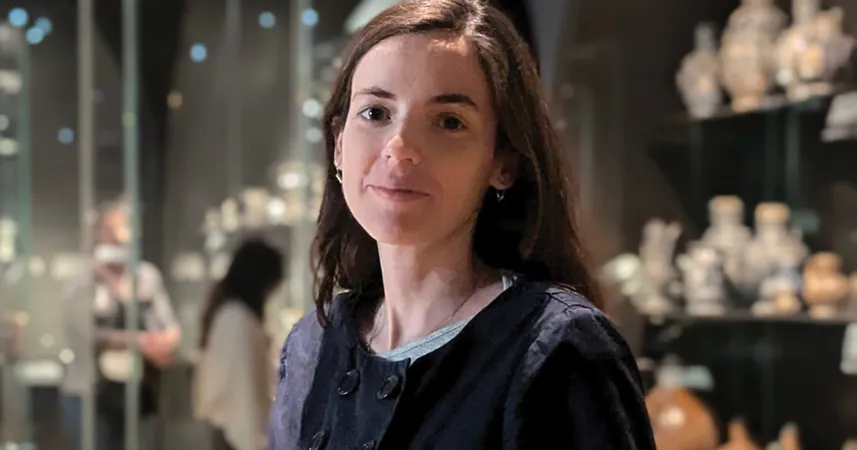
Revolutionizing Art Conservation: Alba Álvarez-Martín Brings Mass Spectrometry to Museums
2025-01-02
Author: Wei Ling
Introduction
Growing up in the picturesque city of Salamanca, Spain, Alba Álvarez-Martín developed an early appreciation for art, inspired by her father, a talented sculptor. While she did not inherit his artistic skills, her fascination with the sciences—particularly physics, math, and chemistry—drove her to carve a niche in cultural heritage science. Today, she is a pivotal figure at Amsterdam's prestigious Rijksmuseum, where she applies innovative scientific methodologies to protect and analyze aging artworks.
Groundbreaking Applications
In late 2023, Álvarez-Martín and her team unveiled groundbreaking work utilizing matrix-assisted laser desorption ionization mass spectrometry imaging (MALDI-MSI)—a technique typically rooted in the medical field—to dissect the complex layers of paintings. This approach enables researchers to pinpoint the molecular composition of the various pigments in a painting, revealing invaluable insights about the artist's techniques, the historical evolution of artworks, and how to combat color degradation over time.
Understanding Organic Pigments
As part of her research, she has made significant strides in understanding organic pigments, which often contain chromophores—molecules responsible for color that can degrade under light exposure. By studying the degradation patterns of these pigments, she can recommend optimal light conditions to help preserve the integrity of the artwork. This fascinating intersection of art and science not only enriches our knowledge of art history but also informs conservation practices.
Passion for Mass Spectrometry
In an engaging interview, Álvarez-Martín elaborated on her relentless passion for mass spectrometry. "The dream has always been to use mass spectrometry in a less invasive way, preserving spatial distribution within the art piece while making the findings accessible and understandable to a broader audience," she explains. MALDI-MSI, which visualizes the distribution of molecules without the need for destructive analysis, could redefine how museums approach conservation, allowing for real-time pigment analysis directly within gallery settings.
Innovative Experiments
Her excitement is palpable as she discusses her recent experiments with geranium lake, a vibrant pink pigment widely used by artists like Van Gogh. By recreating historical pigments in her lab, she hopes to better understand their degradation pathways. The challenges of reverse engineering artworks with multiple layers of history excite her scientific curiosity and dedication to art preservation.
Future of Art Conservation
Moreover, Álvarez-Martín's ambitions extend beyond the lab. She envisions a future where portable mass spectrometry instruments are commonplace in museums, allowing curators and conservators to gather data without removing samples from artworks, thereby ensuring minimal disruption and preserving the integrity of invaluable pieces.
Conclusion
With an illustrious career ahead, Álvarez-Martín remains committed to making mass spectrometry not only an essential tool for art conservation but also an accessible one for institutions worldwide. Her pioneering work fosters a greater appreciation for the intricate dance between science and art, reaffirming that the key to unlocking the mysteries of history may lie in the very pigments that bring these masterpieces to life.
As we march further into the future, her trailblazing spirit and unwavering dedication inspire a new generation of scientists and artists alike to join in the mission to safeguard our cultural heritage. Keep an eye on this rising star—her next breakthrough might just change the way we view art conservation forever!





 Brasil (PT)
Brasil (PT)
 Canada (EN)
Canada (EN)
 Chile (ES)
Chile (ES)
 Česko (CS)
Česko (CS)
 대한민국 (KO)
대한민국 (KO)
 España (ES)
España (ES)
 France (FR)
France (FR)
 Hong Kong (EN)
Hong Kong (EN)
 Italia (IT)
Italia (IT)
 日本 (JA)
日本 (JA)
 Magyarország (HU)
Magyarország (HU)
 Norge (NO)
Norge (NO)
 Polska (PL)
Polska (PL)
 Schweiz (DE)
Schweiz (DE)
 Singapore (EN)
Singapore (EN)
 Sverige (SV)
Sverige (SV)
 Suomi (FI)
Suomi (FI)
 Türkiye (TR)
Türkiye (TR)
 الإمارات العربية المتحدة (AR)
الإمارات العربية المتحدة (AR)